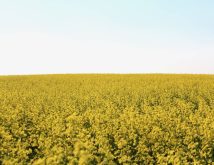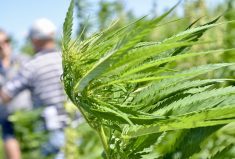A lot of last year’s woes came down to the luck of the draw in terms of weather and pest and diseases issues, but the big exception to that was blackleg
It was a year to forget for Manitoba canola growers.
If you’re keeping a scorecard, the list of problems suffered by growers in 2012 included high weed pressure in fields that were waterlogged in 2011, frost hitting some early-seeded crops, a blistering hot July, insect populations just under the level that warrants spraying, aster yellows and blackleg.
Chalk up most of it to bad luck, save for blackleg which “definitely is one of my biggest concerns for canola production in the future,” agronomy specialist Angela Brackenreed told farmers at Ag Days.
Read Also

Journal pulls long-cited glyphosate study for ethics violations
The journal Regulatory Toxicology and Pharmacology has retracted a 2000 Monsanto-linked glyphosate review, drawing new scrutiny as Bayer faces mounting legal pressure.
Canola infected with blackleg before the six-leaf stage usually suffers substantial yield loss as it causes lesions that girdle the base of the stem and choke off the uptake of water. It often results in lodging, too.
“In the summer, the symptoms are buff-coloured, round to irregular spots with black fruiting bodies. Stem lesions later in the season cause premature plant death,” notes the website of Manitoba Agriculture, Food and Rural Initiatives.
Farmers who spot the latter symptom often think they have sclerotinia, but that’s a mistake you don’t want to make, said Brackenreed, who works for the Canola Council of Canada. (For detailed scouting info, go to www.gov.mb.ca/agriculture and type blackleg in the search box.)
Disease survival
The disease can survive for two or more years on stubble, infect seed, and also survive on brassica-type weeds. It’s also shown a talent for successful mutation and blackleg-tolerant varieties are becoming less so, said Brackenreed.
Using certified seed and planting tolerant varieties does help, as does rotating fungicides, but if you’re serious about avoiding it, then plant canola less often in your rotation, she said.
“You need to add diversity to your farms,” Brackenreed said.
There are some additional lessons to be drawn from 2012.
One was a reminder that early isn’t always better. Some early-seeded fields struggled all year — likely because they were knocked off stride by an early frost — while later-seeded ones chugged along.
“Some think the later-seeded stuff actually performed better because it was kind of continually and evenly stressed throughout the season and it just allowed it to adapt,” Brackenreed said.
The year also provided food for thought in regard to insect control. While canola-attacking insects got off to an early start, populations often didn’t warrant spraying. Moreover, these pests can be kept in check by beneficial insects. So the question becomes: Is it worth killing the bad guys when it means taking out the good ones, too?
Brackenreed noted one study that caged honeybees with canola and compared it to canola without any honey-making friends. The canola with bees not only had twice the number of pods (815 versus 359) but also more seeds per pod (20 versus 15).
“So it’s really important to consider that when you’re going in and spraying that these guys can increase your yield and if you’re not even at that economic threshold yet you could be throwing money away in two ways,” Brackenreed said.
Last year also emphasized the need to get your seeding rate right. Five plants per square foot is the minimum, and seven is better, she said.
“To reach 100 per cent (yield potential) at five plants per square foot you’re really going to have to have everything stacking up in your favour,” she said.
Farmers should know the 1,000-kernel weight of their canola seed. A 2009 survey found most farmers stick with five pounds of seed per acre. But heavier seed means fewer plants per square foot, and since only abut 60 per cent of athe seed plant produces viable plants, seeding rates need to be adjusted accordingly.
Seed weight
A farmer planting seed weighing 7.1 grams per 1,000 seeds would need almost eight pounds an acre to get a decent population, said Brackenreed. That would be too expensive, she added, so farmers would want to increase management to assure an adequate number of plants.
“If your 1,000-kernel weight changes between fields by a gram you should be thinking about recalibrating your drill,” she added.
And while farmers can’t control the weather — such as preventing July’s heat wave — they can make adjustments. Brackenreed noted the best time to swath canola is when 60 to 70 per cent of the seed has changed colour. But many farmers start cutting earlier because they have so many acres to get done.
She said one alternative option is to seed varieties with different maturities so swathing and harvest can be spread out.















